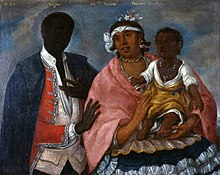The examples and perspective in this article may not represent a worldwide view of the subject. (September 2024) |
Sambo is a derogatory label for a person of African descent in the Spanish language. Historically, it is a name in American English derived from a Spanish term for a person of African and Native American ancestry. After the Civil War, during and after the Jim Crow era the term was used in conversation, print advertising and household items as a pejorative descriptor for black people. The term is now considered offensive in American[1] and British English.[2]

Etymology
editSambo came into the English language from zambo, the Spanish word in Latin America for a person of South American negro, mixed European, and native descent.[3] This in turn may have come from one of three African language sources. Webster's Third International Dictionary holds that it may have come from the Kongo word nzambu ('monkey'). The Royal Spanish Academy gives the origin from a Latin word, possibly the adjective valgus[4] or another modern Spanish term (patizambo), both of which translate to 'bow-legged'.[5][6]
The equivalent term in Brazil is cafuzo. However, in Portugal and Portuguese-speaking Africa, cafuzo is used to refer to someone born of an African person and a person of mixed African and European ancestry.[7]
Another possibility is that Sambo may be a corruption of the name Samba (meaning "second son" in the language of the Fulbe, an ethnicity spread throughout West Africa). Michael A. Gomez has argued that Sambo is actually a Muslim name and that men named Sambo in the South were likely to have been slaves who practiced Islam.[8]
Literature
editExamples of Sambo as a common name can be found as far back as the 19th century. In Vanity Fair (serialised from 1847) by William M. Thackeray, the black-skinned Indian servant of the Sedley family from Chapter One is called Sambo. Similarly, in Uncle Tom's Cabin (1852) by Harriet Beecher Stowe, one of Simon Legree's overseers is named Sambo. Instances of it being used as a stereotypical name for African Americans can be found as early as the Civil War.
The name Sambo became especially associated with the children's book The Story of Little Black Sambo by Helen Bannerman, published in 1899. It was the story of a southern Indian boy named "Sambo" who outwitted a group of hungry tigers. Bannerman also wrote Little Black Mingo, Little Black Quasha, and Little Black Quibba.[9][10]
Places
editSambo's Grave
editSambo's Grave is the 1736 burial site of a young Indian cabin boy or slave, on unconsecrated ground in a field near the small village of Sunderland Point, near Heysham and Overton, Lancashire, England. Sunderland Point used to be a port, serving cotton, sugar and slave ships from the West Indies and North America.
Sambo's restaurant chain
editThe once-popular Sambo's restaurant chain used the Helen Bannerman images to promote and decorate their restaurants, although the restaurants were originally claimed to have been named after the chain's co-owners, Samuel Battistone and Newell Bohnett.[11]
See also
editReferences
edit- ^ "Definition of "Sambo" (US English)". Oxford Dictionaries Online. Archived from the original on December 24, 2015. Retrieved 24 December 2015.
- ^ "Definition of 'Sambo' (British and World English)". Oxford Dictionaries Online. Archived from the original on September 26, 2015. Retrieved 24 December 2015.
- ^ Forbes, Jack (1993). Africans and Native Americans: The Language of Race and the Evolution of Red-Black Peoples. University of Illinois Press. p. 235.
- ^ Collins Latin Concise Dictionary. UK: HarperCollins Publishers. 1997. ISBN 978-0-06-053690-9. English-Latin section, p. 20.
- ^ "patizambo" (translation). Password Spanish–English Dictionary. Cambridge University Press. 2014.
- ^ Bogost, Ian (2015). How to Talk about Videogames. Minnesota, United States: University of Minnesota Press. pp. 28–33. ISBN 978-0-8166-9911-7. Retrieved 13 July 2023.
- ^ "cafuzo". Dicionário Priberam da Língua Portuguesa (Online ed.). Lisbon: Priberam. 2008–2021. Retrieved 7 January 2022.
- ^ Gomez, Michael A. (1994). "Muslims in Early America". The Journal of Southern History. 60 (4): 671–710. doi:10.2307/2211064. ISSN 0022-4642. JSTOR 2211064.
- ^ Helen Bannerman (1902) The Story of Little Black Quibba
- ^ Bogost, Ian (2015). How to Talk about Videogames. Minnesota, United States: University of Minnesota Press. pp. 28–33. ISBN 978-0-8166-9911-7. Retrieved 13 July 2023.
- ^ Molina, Joshua. 4 June 2020. "BizHawk: Sambo’s Owners Heed Protesters’ Call to Change Name of Santa Barbara Restaurant." Noozhawk.
Bibliography
edit- Boskin, Joseph (1986) Sambo: The Rise and Demise of an American Jester, New York: Oxford University Press
- Goings, Kenneth (1994) Mammy and Uncle Mose: Black Collectibles and American Stereotyping, Bloomington: Indiana University Press, ISBN 0-253-32592-7
External links
edit- e-texts of The Story of Little Black Sambo: